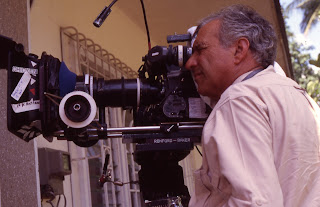Another lost-and-found discovery has graced my ongoing research into the life and work of filmmaker Sidney J. Furie. (I hope to one day publish an updated version of my book on Mr. Furie, so the digging continues.) And when I say "another" discovery, I'm also referring to my three-year effort to find and rescue Sidney's sophomore feature A Cool Sound from Hell (1959), which is detailed here.
And check out my new Keyframe article "Canada Lost and Found" which covers the Toronto Film Festival premiere of A Cool Sound from Hell, published September 28, 2016.
Recently, editor Saul Pincus succeeded in digging up the 149-minute director's cut of Sidney's 2001 Canadian feature Going Back, a film about a traumatized group of Vietnam veterans who return to Saigon in the nineties with a television documentary crew. Sidney and his writer Greg Mellott based Going Back on a "Nightline" special they had caught when broadcast around that time.
In the United States, the film emerged with forty minutes missing, under the dubiously more "commercial" direct-to-video action title Under Heavy Fire. To add insult to injury, the film had also been severely cropped and panned-and-scanned from 2.35:1 to 1.33:1, with chronic interlace "combing" issues prevalent throughout. And there was another ingredient in this migraine-inducing cocktail: video and audio were also a full four frames off-synch through the whole film. This was a hatchet-job, and a heartbreaking experience for its creators, who invested an inordinate amount of time and effort in this particular project. It took years to engineer a working script (nearly 400 pages), then acquire the resources to actually shoot in Vietnam (it allegedly was the first production to do so following the American intervention into Vietnam).
When the film was mutilated, everyone involved, including its cinematographer and editor, rallied unsuccessfully to rescue it from its fate. Says Saul Pincus, "I took the initiative and met with the distributor Alliance/Atlantis and told them we wanted to do a special edition, and release the long version in 2.35:1. I also insisted that we approve the encode, and to that end, enlisted a house to do the work. It was gratis because we didn’t have a budget. I collected the electronic press kit, now long lost, and did new video interviews with Sid, [producer] Gary [Howsam], and a small number of principal crew. In the end, the encoding house dropped out and we never did get the work completed"
A feature-length group commentary track was even privately arranged. The film, of course, never secured the better release its makers sought for it, and the commentary track festered for years on one of the editor's old RAID drives. Saul recently found that too, thankfully.
There were about nine 35mm anamorphic Dolby Digital prints made of the long version in May 2001. Those prints went off to the Cannes Film Festival market, among other destinations, and were never to be seen again. After the short 112-minute version was cut, the post supervisor elected to have the only anamorphic internegative cut to match the short version edit. In summary, the negative for the director's cut was destroyed.
A handful of release prints were struck from this for the Toronto International Film Festival screening in 2001, plus a brief Canadian theatrical release in fall 2001. This is why all versions of Going Back/Under Heavy Fire are compositionally a nightmare – the anamorphic interneg, and not the flat, Super 35 interpositive, was the source.
As the director's biographer, and an admitted fan, I was understandably less than impressed with the film in the butchered American DVD version, finding much to call subpar, especially in terms of visual quality. The narrative also felt rushed, and occasionally too much like a sizzle reel, with the character development backgrounded in favor of stringing its action scenes together more efficiently. In everyday parlance, it was rather “meh,” but with a few moments of brilliance.
I upgraded to a now out-of-print Canadian DVD, a widescreen, de-interlaced iteration of the same shortened version. Although this greatly improved my experience of seeing the film (it is amazing what much-improved video quality can do) and I wound up rating the film higher on this second viewing, something still felt missing. I expressed this to Sidney at the time. He avoided imparting the film's sob story for fear it would become a too-familiar preachy sermon about a director cheated. (I later got that scoop out of Saul the editor.)
In the newly resurrected 149-minute version (seen only privately and not available commercially, at least yet), it has become, for me, one of Sidney's masterpieces. When I saw it and raved about it, Sidney exclaimed one day over the phone to me, "Weren't we robbed?!" I had to say yes, unequivocally. Allegedly, they had enough for a five to six hour miniseries. One day...maybe one day, people will see it the way it was intended.
Eminent film scholar Gerald Pratley noted having seen this original 149-minute cut of Going Back. In his book, A Century of Canadian Cinema, Pratley calls it “a striking, powerful and penetrating war film set in Vietnam. This must have been a very difficult film to make, but Furie pulls it off ably. It is bound to stir up controversy in its depiction of a debatable war.” He then observed that its opening during the inception of Bush Jr.'s Iraq War would stir needed discussion about a fresh brewing political crisis. In my view, Going Back's rugged sensitivity in rendering a story about the plight of war veterans calls to mind one of the greatest American films to do so: William Wyler's The Best Years of Our Lives (1946).
Stay tuned for further developments!




No comments:
Post a Comment